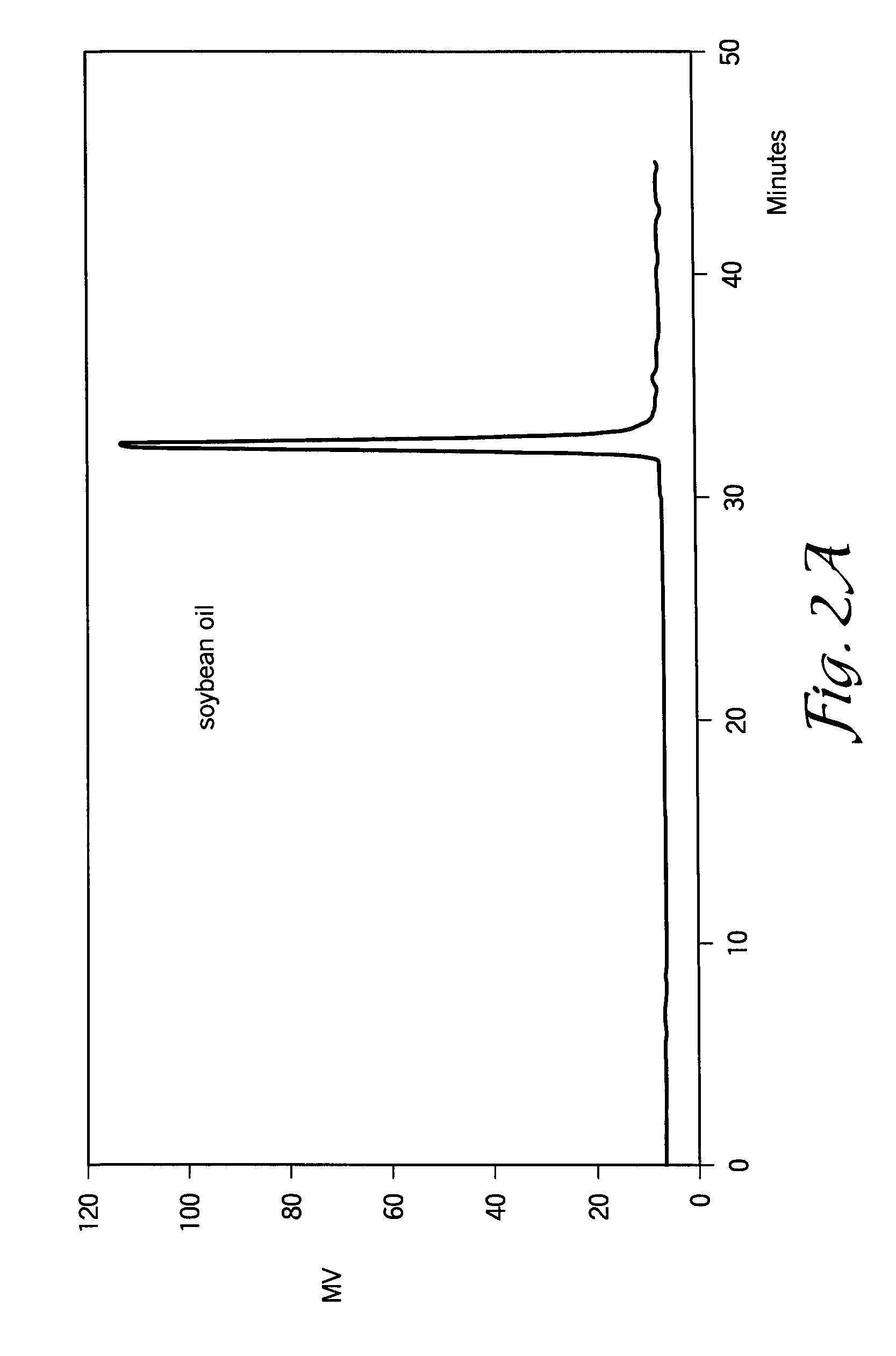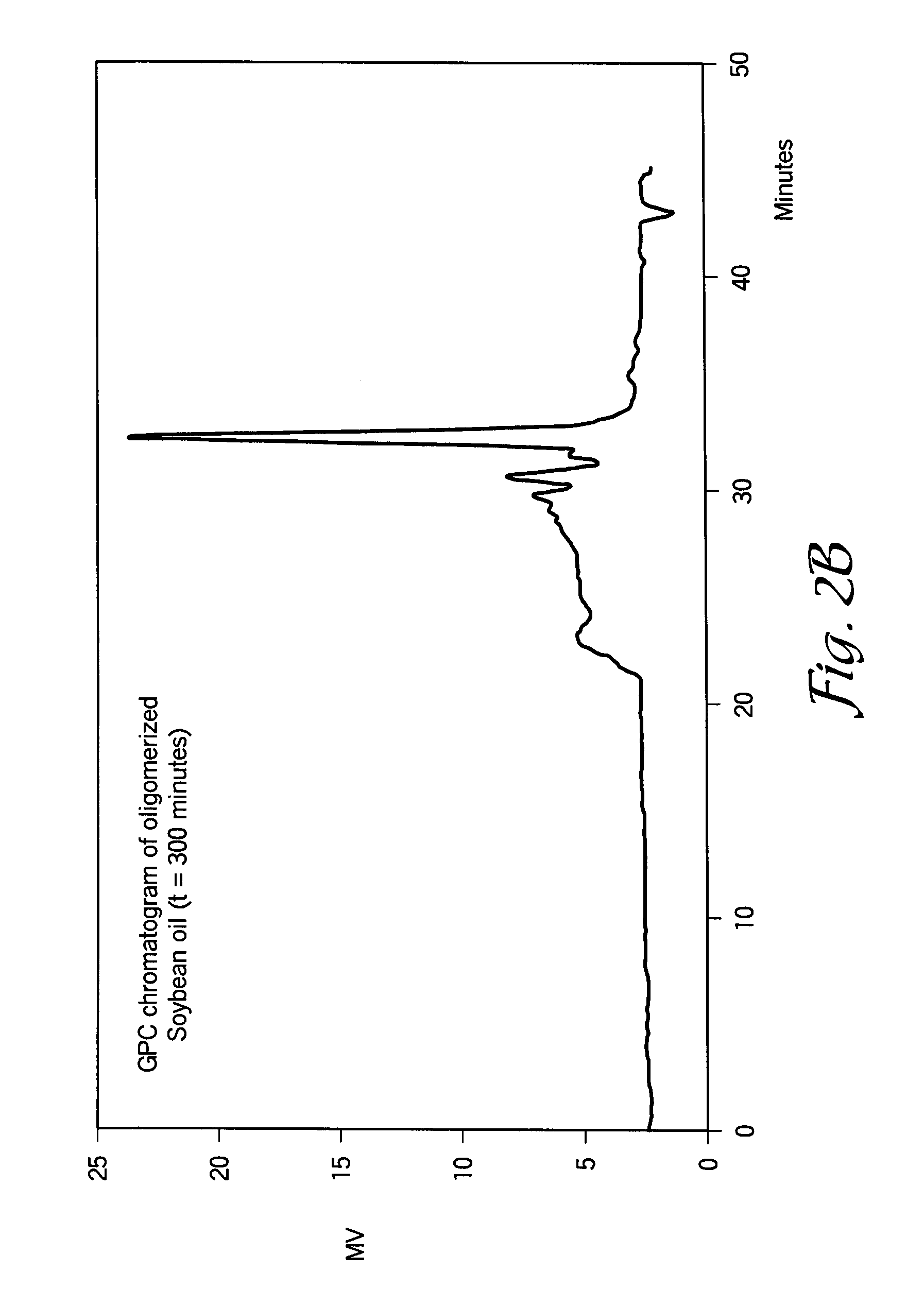Cationic polymerization of biological oils
a technology of biological oils and cationic polymerization, which is applied in the direction of fatty acid chemical modification, inks, domestic articles, etc., can solve the problems of high energy consumption of the process and the relatively long time of the polymerization process, and achieves low number of double bonds consumed in the polymerization process, high concentration of double bonds, and high viscosity.
- Summary
- Abstract
- Description
- Claims
- Application Information
AI Technical Summary
Benefits of technology
Problems solved by technology
Method used
Image
Examples
example 1
[0075]Soybean oil is one of the most important vegetable oils, representing about 25% from the total oils produced worldwide. The high unsaturation (I.V. about 125-132 g I2 / 100 g) and the presence in the structure of about 22-25% oleic acid (one double bond), about 52-55% linoleic acid (two double bonds) and about 6-7% linolenic acid (three double bonds) provide a good capacity for polymerization.
[0076]In this example, a 1 L glass reactor was charged with about 500-600 g of standard soybean oil (IV=125-131 g I2 / 100 g of oil) and about 9.5 ml of 54% solution of HBF4 in diethylether (1% of pure HBF4). The oil / catalyst mixture was stirred at room temperature for about 40-60 minutes under a protective atmosphere by bubbling nitrogen through the reaction mixture. In this interval of time, the color of the soybean oil changed from yellow to dark brown due to the formation of cationic active centers, probably conjugated allyl cations. Within about 20-30 minutes...
example 2
Cationic Polymerization of Sunflower Oil, Safflower Oil, Corn Oil and Linseed Oil
[0083]In this example, the ability of superacids to polymerize other biological oils was investigated. In general, other biological oils underwent cationic polymerization in a similar way as soybean oil, leading to formation of new molecular species having higher molecular weight than the initial oil, but with lower viscosity. In particular, FIGS. 6, 7, 8, and 9 show GPC curves of sunflower oil, corn oil, high oleic safflower oil, and linseed oil, respectively. The relative amount of oleic, linoleic, and linolenic acids in these oils are shown in FIG. 10. It will be appreciated to those skilled in the art that the fatty acid content of the biological oils may vary depending upon the source (e.g., location of production).
[0084]It is observed that in spite of relatively high polymer content, the viscosity of cationic polymerized sunflower oil, safflower oil, and corn oil is low, probably due to the low co...
example 3
Cationic Polymerization of Tung Oil
[0086]Tung oil is a biological oil containing unsaturated fatty acids with conjugated double bonds. Tung oil has 75-85% of alpha-eleostearic acid, an isomer of linolenic acid, having the three double bonds in a conjugated triene structure. The double bonds are 9-cis, 11-trans, and 13-trans. The I.V. of tung oil is about 168-170 g I2 / 100 g.
[0087]Cationic polymerization of tung oil in the presence of a superacid such as HBF4, at 90° C., was rapid violent, giving in less than ten minutes a cross-linked polymeric solid powder of dark red-brown color. The conjugated double bonds are much more reactive in cationic polymerization than the double bonds of some other vegetable oils or fish oil having allylic and bis-allylic structure. In this group of conjugated oils, with potential high reactivity in cationic polymerization are oiticica oil (18:3, about 75-80% fatty acids with conjugated double bonds), dehydrated castor oil (18:2, 90% fatty acids with conj...
PUM
| Property | Measurement | Unit |
|---|---|---|
| Temperature | aaaaa | aaaaa |
| Temperature | aaaaa | aaaaa |
| Temperature | aaaaa | aaaaa |
Abstract
Description
Claims
Application Information
 Login to View More
Login to View More - R&D
- Intellectual Property
- Life Sciences
- Materials
- Tech Scout
- Unparalleled Data Quality
- Higher Quality Content
- 60% Fewer Hallucinations
Browse by: Latest US Patents, China's latest patents, Technical Efficacy Thesaurus, Application Domain, Technology Topic, Popular Technical Reports.
© 2025 PatSnap. All rights reserved.Legal|Privacy policy|Modern Slavery Act Transparency Statement|Sitemap|About US| Contact US: help@patsnap.com



